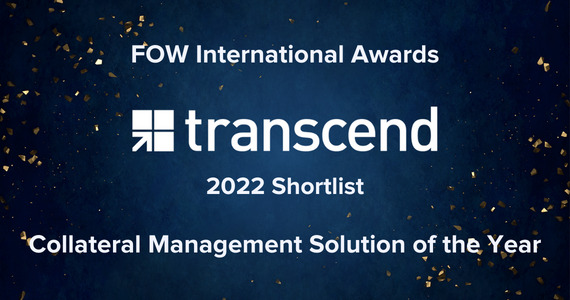
After over 120 entries have been reviewed, the FOW International Awards shortlist has been released. The winners will be unveiled at a Gala Dinner in London on 7 December.
For Original Publication , Click here: FOW Awards 2022


After over 120 entries have been reviewed, the FOW International Awards shortlist has been released. The winners will be unveiled at a Gala Dinner in London on 7 December.
For Original Publication , Click here: FOW Awards 2022

Finadium featured Transcend in a new survey on Collateral Management Technology Vendors in 2021. The survey presents an inside look at the technology vendors who are leading the future of collateral technology – and the incredible feats clients can accomplish with them.
Finadium profiles Transcend as a solution to manage collateral, funding, and liquidity within distinct business lines and across the enterprise. By connecting data and processes across disparate systems, Transcend’s holistic solutions help clients run sophisticated analytics, optimization and automation.
“Transcend was purpose-built to provide the most advanced post-trade collateral optimization capabilities in the industry.”
– 2021 Finadium Collateral Management Technology Vendor Survey
Finadium subscribers can download the survey to learn more about Transcend’s role in driving more effective collateral management and collateral optimization, as well as some new functionality recently added to the Transcend platform.
Learn More About Transcend
Transcend empowers financial institutions to maximize enterprise-wide financial performance and
operational efficiency. Through real-time global inventory and collateral management and optimization
solutions, Transcend helps clients manage intraday liquidity, funding and regulatory requirements.
With seamless workflows that connect front office decision-making with back office operations,
Transcend’s innovative technology promotes smarter investment decisions and improved financial
performance.
Contact the Transcend team for more information on our fully integrated suite of solutions.

When it comes to collateral and inventory optimization, how do you know how your firm stacks up to industry best practices? How can you benchmark your progress, and importantly, pinpoint opportunities to solve inefficiencies?
Download Transcend’s Collateral Benchmarking Checklist and get a quick one-page snapshot to compare your firm’s funding, liquidity, optimization and risk capabilities to industry leaders.
The Transcend team would be happy to walk you through your assessment and discuss how to prioritize your optimization strategy to drive better results for your business – and in the shortest possible timeframe.

Transcend’s CEO, Bimal Kadikar, recently connected with Peter Lee, Editorial Director of Euromoney. The two discussed some of the critical challenges banks face related to increasing margin demands, especially for CCP margin management. Click here to read Peter Lee’s full article summarizing the discussion on Euromoney.
With market volatility, not only does margin increase, but so does the frequency of margin calls. As a result, banks struggle to manage the increased activity in a scalable and efficient way. Furthermore, CCPs are becoming key players with regulators continuing to encourage OTC derivatives; as a result, firms must balance complying with unique and complex CCP eligibility requirements with posting optimal collateral.
“What is clear is that as volatility rises, not only does required margin climb but so too does the frequency of margin increases.”
– BIMAL KADIKAR
As the operational complexity of funding margin requirements grows, technology can help.
Bimal created Transcend in 2013 to help firms increase transparency across businesses with aggregated view of collateral and margin requirements. Earlier this year, Transcend launched CCP Central to help firms aggregate CCP data and automatically pledge optimal collateral. By automating CCP margining, Transcend makes it simple to optimally and efficiently fund cleared derivatives CCPs.
The benefits of leveraging technology to streamline CCP margin management not only helps banks efficiently and scalably meet margin requirements at CCPs, but also creates an opportunity for firms to fold OTC derivatives into a broader optimization strategy.
Click here to learn more about CCP Central.

We’re delighted to announce that Transcend has advanced to the final voting round in the category of Best Cutting-Edge Solution in the FTF News Technology Innovation Awards 2021. The FTF Awards recognize organizations and professionals who have made noteworthy achievements in operational excellence during 2020. The Best Cutting-Edge Solution award will honor the industry participant who has successfully developed innovative financial technology solutions for middle- and back-office post-trade operations.
Winners will be decided by an industry-wide vote that will close on May 14. Transcend invites industry professionals to participate in the voting process.
Over the last 12 months, Transcend has empowered financial firms, including G-SIBs, with smart optimization solutions that automate inventory, funding and liquidity for collateralized businesses. Transcend is the first platform to deliver real-time, enterprise-wide capabilities to fully optimize margin and collateral inventory. The holistic solution achieves unparalleled business results, including reducing the use of unsecured funding by billions of dollars across the capital markets. 2020 enhancements include an integrated booking service to execute collateral allocations from the optimization engine, with full transparency, traceability and entitlements, and end-to-end triparty optimization and allocation for STP.
In October, Transcend raised $10M, closing its Series A round, led by NYCA and a global custodian.
Cast your vote today for Transcend as the industry’s Best Cutting-Edge Solution. Thank you for your support!

The business of collateral optimization has changed radically. In 2020, banks can no longer accept linear priority lists for collateral delivery because when viewed globally across balance sheets and product lines, this no longer makes sense. What was a cutting-edge solution even five years ago is now leaving money on the table. Automation is a central part of this change.
Automation of collateral optimization has shifted how solutions get implemented. While both vendors and institutions would always prefer one solution that provides turnkey results, it now requires far more than simply the ordering of collateral lists to deliver the outsized value seen in the past.
Optimization is an ongoing process that requires both sophisticated software and engaged stakeholders. In this article we discuss recent client lessons, including five key observations from clients on how institutions need to consider collateral optimization, and how our clients are approaching the next complex layer of global inventory optimization.
Collateral optimization requires a complex mix of people and technology. While automation is usually a desired end-state, there are an extensive number of processes, regulatory and client constraints that need to be incorporated first. In the past few months, Transcend has learned some important lessons working with clients:
These examples are the next iteration of collateral optimization, which recognizes the importance of both automation and also the realistic limitations of a human-centered process.
Aggregating inventory globally to a central data hub ensures that collateral optimization considers all available assets at any given times. It sounds easy but in practice contains substantial complexity, in particular the requirement that systems communicate with each other and that descriptive information about each asset is collected and accurate.
To date, collateral optimization has been a tactical and localized process. Individual business units have successfully delivered optimization for their region or silo but that has left the firm as a whole in the dark about where enterprise scalable opportunities may lie. Few firms have a holistic optimization strategy in place and fewer still have implemented one globally, but most recognize that tactical solutions have reached their limits. The next evolution of collateral optimization needs to occur to deliver on its promise of reduced costs and greater operational efficiency.
In an earlier article, Connected Data: The Opportunity for Collateral and Liquidity Optimization, I discussed the importance of connected data, or metadata, to global inventory management. This information covers: the tenor of a position; who the owner is; whether the position is owned by the firm or a client; rehypothecation status; and where it can be pledged at the lowest haircut. This enrichment process is still not conducted by most firms, resulting in real opportunity costs as assets aren’t fully optimized against the firm’s liabilities.
A global inventory optimization effort looks to solve for this problem by developing and assigning connected data to each asset. The process can be complex, but the end results deliver a level of collateral optimization that is robust and scalable. This is a cornerstone of broadening out the impact that optimization can have for financial services firms, starting from data and delivering through to actionable results.
Effective global inventory optimization is an input to solving an array of other problems, including:
Solving the problems of global inventory management and process automation while building tools for human/technology/process engagement is Transcend’s core business. The client examples discussed here show that collateral optimization works best with tools that are well thought-out in advance. We continue to work with our clients to explore where the boundaries lie in optimizing not just collateral but also the process.
Automation of collateral optimization can clearly be a competitive advantage. With hundreds of millions in revenue on the line, advanced firms are now looking to integrate pre- and post-trade across silos. Deciding whether to use collateral for a repo vs. deliver for an OTC derivatives transaction has been discussed since optimization has been around, and firms are now in a position to actualize this intelligence. Collateral optimization is not easy, but the promise of delivering meaningful results to the front office could unlock a new generation of technology development in the collateral space.
This article was originally published on Securities Finance Monitor.

On July 9, 2020, Bimal Kadikar, CEO of Transcend, spoke on the ISF-ISLA panel discussion on “COVID-19 & Chain Reactions: The Transmission of Effects Across Markets & Institutions.” The group discussed what has been expected and unexpected during the health crisis. And based on lessons learned what changes can be expected from business, operations and technology perspectives? Read more in the Global Investor article, “Covid could lead to fungible margin model – panel” for a recap on the discussion.
“Firms struggled to get a clear picture of their #collateral and margin exposures during the most volatile months of the crisis…We expect this to bring more focus to centrally coordinated collateralised businesses and operations.”
– Bimal Kadikar, CEO, Transcend
Panel participants were:

In collateral management, no news is very good news. The collateral management industry deserves congratulations for making almost no noise over the last few months. Nothing grabs headlines like a disaster, but the mainstream press has been remarkably quiet about collateral management functioning. In a new Finadium report, vendors, custodians, outsourcing managers and central securities depositories discussed collateral management and covid-19.
“The crisis is reinforcing our value proposition: clients are asking for more STP; more connected data; more scalable infrastructure; and reduced reliance on legacy systems.”
– BJ Marcoullier, Head of Sales, Transcend
Learn more about how Transcend’s solutions simplify the operational challenges of collateral management and covid-19.

A US regime that a large number of global market participants are starting to fully assess could leave firms crunched for time to implement a comprehensive end-to-end solution, according to BJ Marcoullier, Transcend’s head of sales.
Qualified Financial Contracts (QFC) recordkeeping, a US regulatory regime that will be in its final and largest phase as of June 2021, is designed to reduce market instability in the case of failure of a major financial institution, as detailed under the Dodd-Frank Act, and is one of the regimes designed to prevent another financial crisis.
Access Global Investor Group’s full report: US regulation could leave firms “scrambling”.

NEW YORK, NY (February 10, 2020) – Transcend, a leading provider of real-time collateral and liquidity optimization technology, has hired Lis Hadingham to join Transcend’s sales team, led by BJ Marcoullier. Hadingham brings more than 20 years of experience in the securities finance industry, with extensive background in collateral management and financial technology sales. Her start coincides with an accelerating pipeline of opportunities for Transcend, whose solutions are currently implemented at major banks, including GSIBs.
Before joining Transcend, Hadingham was Managing Director and non-executive board member at CloudMargin where she launched and led the firm’s sales and business development initiatives in the Americas. Prior to CloudMargin, Hadingham held senior roles at FIS (formerly Sungard) selling collateral management and securities finance software solutions, and at Citibank’s Capital Markets group focusing on equity finance sales for repo and securities lending. Prior to Citibank, Lis spent 14 years at J.P. Morgan Chase, initially in London and then New York, successfully helping expand the bank’s collateral solutions.
“We are excited to welcome Lis to our growing team of experts at Transcend,” said Marcoullier. “Her extensive experience leading sales in the collateral management and securities space will play a pivotal role as Transcend supports a growing roster of clients and unique products.”
“Innovation in the collateral management space is crucial to meeting growing regulatory requirements,” said Hadingham. “I’m thrilled to join the Transcend team of experts in helping evolve the industry’s capabilities in global inventory optimization, regulatory reporting and operational efficiency.”
###
About Transcend
Transcend is a leading provider of real-time global inventory and collateral management optimization technology, enabling clients to manage intraday liquidity and regulatory requirements across capital markets. With a modular, front-to-back office approach, clients harness real-time data, collateral and liquidity across their enterprises to unlock greater efficiencies and improve returns on investments. For more information, visit www.transcendstreet.com.
Media Contact
Zain Abouseido
Paragon Public Relations
zain@paragonpr.com
+1.646.558.6226

At Transcend, we have seen a growing shift in the industry towards firm-wide optimization of collateral, liquidity and funding. Our clients’ goals are to manage their capital more effectively and drive efficiencies across the enterprise, and that requires a coordinated, integrated and automated approach across siloed business lines, systems and processes. It is no small task to connect and harmonize vast sets of data related to collateral – such as agreements, positions and trades – and various workflows, but the returns are quickly realized. The good news is that firms can pursue their optimization strategy widely, or they can choose to focus on a priority area of their business and scale from there.
In 2020, we expect a continued increase in complexity and bottom-line pressures. Firms need to provide differentiated, competitive services to drive profitability, despite potentially operating with legacy technology and processes. Plus, they face growing reporting requirements and regulatory pressures (such as QFC Recordkeeping and SFTR). This is leading more firms to the realization of the need – and benefits – to undertake a centralized optimization strategy to help overcome multiple challenges through a singular solution.
Everyone understands that automation in the funding and collateral space is occurring at a fast pace. At Transcend, we believe that in five years, as much as 90% of funding will be done by machines. But what is not fully in focus is that connecting data from disparate sources is the key to this next evolution in the funding markets. Today, most data is fragmented across a firm. To be effective, data needs to flow from the original sources and be readable by each system in a fully automated way. Thus, harmonizing and connecting data needs to be every firm’s priority in order to achieve automation and optimization.
This article was originally published on Markets Media.

Recent advances in collateral management technology – from algorithms to advanced analytics – are revolutionising the opportunities available to firms seeking optimisation at an enterprise-wide level.
Firms are increasingly realising the advantages of adopting a more centralised and harmonised approach to managing collateral, and utilising the latest software solutions to inform decision-making. Bimal Kadikar, CEO at Transcend, says: “Forward-looking firms have recognised that optimising collateral and liquidity across an enterprise, as well as within business areas, can drive efficiencies and deliver wider strategic benefits.”
Continue reading “A Connected Collateral Ecosystem”